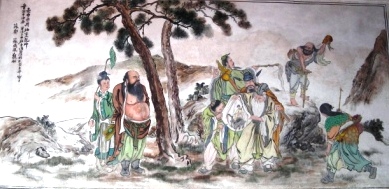
| Home | Chinatowns of the world | Festivals | Culture | Food Culture | History | Countries |
| Chinese Religion | Tours | Sitemap | Documentaries | About | Contact |
|
Tainan Grand Matsu Temple
|
Related articles:
 Taiwan
Taiwan
Mazu, 妈祖
Stories from the Ming dynasty
Lists of deities in Tainan Grand Matsu Temple
Main deity: Mazu 妈祖
Mazu’s assistants:
General Qianli Yan, 千里眼将军
GeneralShun Fenger, 順风耳将军,
Mazu’s parents, Mazu brothers and sisters
Dragon Kings of the Four Seas, 四海龙王
Water deities, 水仙尊王:
Da Yu, 大禹
Qu Yuan, 屈原
Wu ZiXu, 伍子胥
Xiang Yu, 项羽
Shou Wang, 奡王, 寒澆
Three Great Emperor Officials:
Gods of Heaven, Earth and Water, 三官大帝
Wenchang Dijun, 文昌帝君
God of Marriage: Old Man under the moon, 月老
Earth God, Fe De, 福德正神
Goddess of Childbirth, 诸生娘娘
Tiger General, 虎爺将军
Guan Yin, 观音
Amitabha Buddha, 阿弥陀佛
Shakyamuni Buddha, 释迦牟尼佛
Medicine Buddha, 药师佛
Weituo 韋馱护法
Guan Gong as Dharma Protector, 伽藍护法
King Nanjing, Zhu Shu Gui
Governor Jiang Yuan-Shu
General Cheng Cheng
Tablets of previous abbots
Note: We try to produce a detail list of deities and apologise if any might have been left out. Also, as time passes, changes to the list of deities is expected.

The Palace of Ming king,
now the
Tainan Grand Matsu Temple


Hungry Ghost Festival

The beams from which the five concubines hung
themselves.



Yue Lao shrine

Notice board of couple's photo inside the Yue Lao shrine

Mural of Eight Immortals

Entrance to the shrine to Goddess of Child Birth

Matsu's assistant
| Join us on | Youtube | |||
| Copyright © 2007-24 Chinatownology, All Rights Reserved. | ||||
 Tainan Grand Matsu Temple
Tainan Grand Matsu Temple